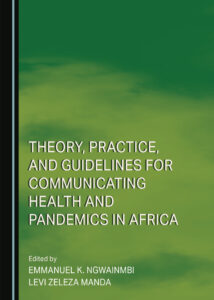Celebrate with us the publication of work from colleagues in the School of Arts and Communication.
The communication chapter discusses results from their 2008 MUSE project.
 African Newspaper Coverage of AIDS and Community Structure Theory:
African Newspaper Coverage of AIDS and Community Structure Theory:
Comparing New Models of Press-State Relations with Structural Factors in Sub-Saharan Anglophone Africa
John C. Pollock, Paul D’Angelo, Amanda Burd, Kristen Kiernicki Lavery,
Janna R. Kimosh, Donna Shaw, The College of New Jersey.
Prof. John Pollock (Communication Studies) asked professors Paul D’Angelo (Communication Studies) and Donna Shaw (Journalism) to join him and three undergraduates — Amanda Burd, Kristen Kiernicki (now Lavery), and Janna Raudenbush (now Kimosh) —for a 2008 summer MUSE research project on health communication. Prof. D’Angelo published one set of results in 2013. Prof. Pollock presented his results at conferences in Mexico City, Singapore, and at Oxford University, finally publishing his final draft as a book chapter in summer, 2023.
The new chapter systematically compared AIDS coverage from 2001 to 2003 and 2005 to 2007 in six major English-language newspapers in six sub-Saharan African countries (633 articles) displaying high and low prevalence of AIDS after placing these countries in the context of three new media system models. The three models were an effort to adapt Hallin & Mancini’s three Global North models of media and politics, primarily in Western Europe, to circumstances in the Global South, in this case sub-Saharan Anglophone Africa. After we (Pollock and D’Angelo) created three original developing country models called “Contained Democratic,” “Instrumental Democratic,” and “Repressive Autocratic,” we compared these “media system” explanatory factors with national-level “structural” factors (such as Gross Domestic Product, literacy rate, life expectancy at birth, infant mortality rate, AIDS prevalence, etc.) to explore the explanatory power of both media system and structural levels of analysis linked to two outcomes: level of reported “progress” in fighting AIDS and level of media emphasis on “government” as opposed to “society”) activity fighting AIDS. One of the results was surprising: In countries with high AIDS levels, the higher the level of (media system factor) government press control in a country, the “greater” the reported progress in fighting AIDS. That is, governments with high levels of press control reported higher levels of success fighting AIDS precisely in countries with the highest AIDS levels! Level of reported progress fighting AIDS had little to do with measured progress fighting that disease, but rather with the ability of governments to direct the press to project a “reputation” for fighting AIDS.
2013 article: D’Angelo, P., Pollock, J.C., Kiernicki, K., & Shaw, D. (2013). Framing of AIDS in Africa: Press-state relations, HIV/AIDS news, and journalistic advocacy in four sub-Saharan Anglophone newspapers. Politics and the Life Sciences, 33(2), 100-125.
2023 chapter: Pollock, J.C., D’Angelo, P., Burd, A., Kiernicki Lavery, K., Kimosh, J.R., and Shaw, D. (2023). African newspaper coverage of AIDS and community structure theory: Comparing new models of press-state relations and structural factors in sub-Saharan anglophone Africa. In E.K. Ngwainmbi & L.Z Manda (eds.), Theory, practice, and guidelines for communicating health and pandemics in Africa (pp. 79-123). Newcastle upon Tyne, UK: Cambridge Scholars Publishing.
